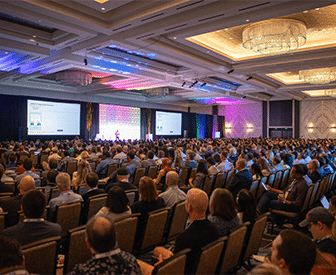In the digital era, every consumer navigates their own individualized buying journey using multiple channels to interact with various financial brands. Typically, they conduct a ton of research on their own before they are ready to engage. Why? Because trust in financial institutions, lost during the financial crisis, is still low. People need to investigate their options to gain some level of comfort with a banking provider before initiating a conversation — the trust just isn’t there.
Given these challenges, filling the sales funnel today requires more sophisticated inbound and outbound marketing by financial institutions — strategies that will address both the increasingly complicated digital customer journey and the broken trust consumers feel.
Generally speaking, people want three things in life: health, wealth, and happiness. Banks and credit unions are in a unique position to help them reach these goals. Money is stressful, affecting people’s emotional, mental, and physical well-being. Just ask anyone who lost money during the Great Recession.
So how can banking providers earn consumers’ trust while automating a complex digital marketing strategy? By leveraging digital marketing strategies focused on platforms (technologies) and pathways (consumer journeys), then applying the following three concrete tactics.

The Power of Localized Marketing in Financial Services
Learn how to enhance your brand’s local visibility, generate more leads, and attract more customers, all while adhering to industry regulations and compliance.
Read More about The Power of Localized Marketing in Financial Services

Success Story — Driving Efficiency and Increasing Member Value
Discover how State Employees Credit Union maximized process efficiency, increased loan volumes, and enhanced member value by moving its indirect lending operations in-house with Origence.
Read More about Success Story — Driving Efficiency and Increasing Member Value
Eliciting Emotion Through Personalization + Automation
“Automation” and “personalization” may seem like contradictory concepts. After all, automation conjures up images of sameness — the opposite of true personalization. But in this new era of marketing, these two concepts are tightly connected. And they must be implemented correctly if financial marketers expect to target individual consumers, earn their trust, and remain a competitor in this digital era.
1. Map your marketing automation strategy to the digital journey of each consumer. Right now, that’s not happening for most financial institutions. According to the State of Digital Growth Report from the Digital Growth Institute, only 16% of banks and credit unions have mapped out digital consumer journeys. Even once a consumer chooses to become a customer, only 24% have a defined digital onboarding process.
2. Personalization builds trust with consumers. Thanks in part to the lingering effects of the financial crisis and other, more recent negative banking headlines, a mere 8% of Millennials trust financial institutions, according to Facebook IQ. People are no longer just looking for another loan or credit card. Now they are looking for something more: someone that they can trust to help them on the path to a more financially secure future. They are looking for help, hope, and guidance to help them move beyond their financial stress.
Consumers scour an average of nine different sources of information over a 60-90 day period when shopping for a financial product, notes the Digital Growth Institute. Yet, communicating with another human being is still the most influential activity in the consumer buying journey for financial products. This means consumers crave an experience that feels individualized and has a sense of intimacy.
Financial marketers need to present relevant information to each person at the right time — introducing the human element at the appropriate junctures. Marketing automation can pinpoint the optimal time to reach out to each individual. Do this and your institution will be one step closer to earning their trust and business, closing the trust gap.
“Connecting on an emotional level moves consumers beyond just the cold facts.”
3. Market to the right brain, not the left brain. Consumers are right-brained, meaning they rely more on feelings and emotions. Banking executives (at least in their business capacity) typically operate from a left-brained perspective, meaning they’re logical, analytical, mathematical and factual. To bridge this gap, financial marketers should apply left-brain analytics to processes that facilitate right-brain communications, such as presenting smart financial choices that appeal to the emotional sense rather than a numbers-first approach.
Connecting on an emotional level (e.g., relating to life’s big events) causes consumers to reflect on a product’s valuable impact within their life and helps them see what it — and the financial institution — can do beyond just the cold fact that it’s, say, a loan with a decent rate. This right-brain approach assists in bridging the trust gap with consistent, relevant communication that provides a pathway to developing a long-term trusted relationship.
Digital Darwinism: How to Keep Up With Consumers
How can banks and credit unions survive in an era where technology and society are evolving faster than most financial firms are able adapt? How can they become — and remain — nimble enough to meet buyers when consumer behavior and technology change so quickly? The answer: mirror your customers in their embrace of digital.
By tracking, measuring, and analyzing consumer interactions, financial brands can market themselves smarter, thereby engaging people, earning their trust, appealing to their sensibilities, and eventually converting them to customers. Technology is an instrumental component of this digital process, with marketing automation often facilitating personalization at scale.
A marketing automation platform, for example, can be set up to do sequenced nurture campaigns, such as for onboarding and surveys with the purpose of providing informational value and collecting additional individual data. They can also be used for segmented nurture programs that can, for instance, hone-in on a type of product the consumer is interested in, based on the “digital breadcrumbs” they leave while browsing the institution’s website or clicking on a related link in an email. The platform scores and segments engagement behaviors related to this product of interest, determining which sales funnel position to use to send emails with relevant calls-to-action in drip campaigns that result in higher lead conversions.

How One Financial Institution Found Success With Analytics
Tower Federal Credit Union applied marketing automation and analytics to its digital marketing process, which helped its marketing team understand and score customers based on their behavior on the institution’s website. With the ability to track customer activity, Tower can segment prospects and automate trigger campaigns that have resulted in a 2x to 3x increase in email open rates and many more customers starting loan applications.
Tower credits these results to analytics which allow them to know where customers are in the buying cycle and what products they’re interested in. In this way, Tower is able to personalize messages and get the most relevant message to the right person at the right time.
Successful digital marketing is much more than having a digital presence — it is engaging through digital channels, cutting through the digital noise and personalizing marketing efforts at scale.
Financial services firms that execute with a digital growth blueprint focused on platforms and pathways will create a customer journey that guides people toward a healthier, wealthier, and indeed happier financial future, building trust and loyalty in the process.







